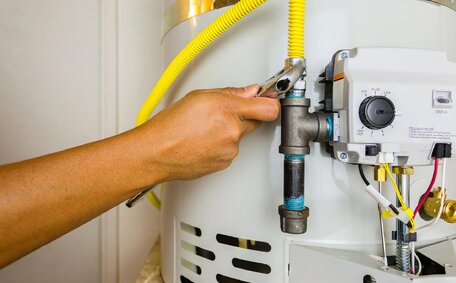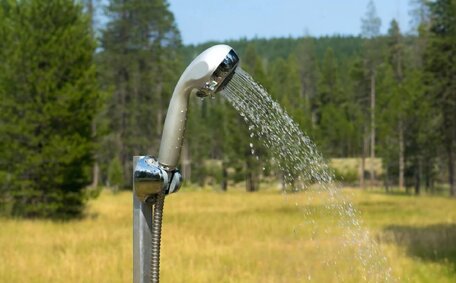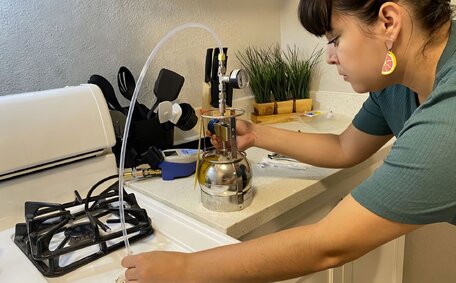Understanding Pipe Relining as an Alternative to Pipe Replacement
Pipe relining is an effective trenchless repair technique that rehabilitates old drainage pipes without necessitating a full-scale replacement.
This innovative process eliminates the need to dig up extensive tracts of your property, providing a non-intrusive alternative to traditional methods.
Locally, household pipes are typically clay or cast iron, prone to rust, scaling, and cracking that cause leaks, blockages, or collapse.
Pipe relining minimises disruption as it usually only needs establishing minor access points into pipes, leveraging existing fixtures.
An inversion drum containing the rigid epoxy resin liner is fed through these access points and, once in place, is inflated using air and water pressure to solidify its position. After a few hours of curing, the old pipe now has a smooth, jointless and corrosion-resistant new internal layer expected to last 50 years or longer.
The liner is pressed tightly inside, conforming and hardening to the existing pipe’s interior surface.
Key Factors That Influence Pipe Relining Costs
The cost per metre of pipe relining is primarily determined by the diameter and total length of pipe needing repair, shaping our plumbing team’s approach. As a rule of thumb, the cost of the method of pipe relining services we use averages around $500 - $700 per metre for standard 100mm to 150mm domestic drains.
The number of access points and pipe connections required after the relining takes place, which might be necessary to navigate the resin liner into the pipes, can influence the final cost. More straightforward, shallow pipe layouts may only need one entry point. Complex pipe configurations buried deep under buildings or yards require extra underground camera inspection and cutting into the pipe from multiple points.
The advanced methods of pipe repair utilising relining techniques, which employ epoxy resin liners capable of withstanding hot wastewater, have significantly enhanced the efficiency and effectiveness of the process. In the pipe relining process, conditions like excessive damage or awkward angles that hinder liner insertion can add extra time, effort, and materials compared to straight piping runs.
Pipe Size and Length
The diameter, or size pipe, along with the total length of pipes needing repair, are critical factors affecting pipe relining costs. Wider pipe drains require more epoxy resin liner material to adequately coat the interior walls of the existing pipe drain. Also, longer sections of a damaged area of the pipe present a greater surface area in need of restoration.
Typically, the cost to reline 100-150mm diameter pipes found under most homes is between $500-700 per metre. However wider pipes like 200-300mm or complex networks exceeding 10 metres can increase materials and labour. Each additional metre of piping adds more time and resin liner to install.
Restoring three separate 10-metre sections of 100mm diameter pipe, each with a projected 50-year lifespan, may require minor cutting for access and typically costs between $15,000 and $21,000. A 30-metre stretch of damaged pipe replace new with 300mm drainage might commence at figures around $30,000-42,000. It is crucial to consider the dimensions of the pipe needing repair when evaluating the cost of pipe relining in comparison to pipe replacement.
Accessibility and Complexity
How effortlessly our plumbing team can gain access to pipes needing repair is a major factor affecting the overall cost. Straight pipe configurations running under the front yard may only necessitate one access point before any work begins, significant in determining the cost pipe relining. Complex systems entombed beneath edifices may necessitate several entry points before any work ensues.
If drainage pipes beneath a concrete driveway or layers of established landscaping require relining, associated restoration work can inflate the cost of pipe repairs. Providing access to pipes concealed in narrow ceiling spaces or behind bathroom fixtures also requires additional time and expertise. The number of access points directly affects the cost of pipe relining.
Certain complications, such as intense root intrusion, sharp bends, or collapsed pipe segments, can increase the costs associated with pipe relining. Although specialised equipment and camera inspections help in properly positioning the liner, difficult angles or extensive damage might incur additional installation costs.
Materials and Labour
The materials and labour involved in pipe relining contribute significantly to the overall cost. Epoxy resin liners are engineered to handle hot water up to 90°C. Manufacturing these to fit various pipe dimensions and shapes requires advanced technology and quality control.
The expertise of our skilled plumbers and the proper relining equipment also influence the installation cost. The process of installing flexible resin liners through tight bends or within partially collapsed pipes requires skill and patience. Inordinate root encroachment or alternative harm may complicate entry, tacking on additional manual toil to finalize the pipe relining job.
Typically, you’ll have one or two skilled plumbers on-site with one feeding the liner down the pipe, while the other monitors progress and ensures correct positioning. The epoxy then requires several hours of careful curing to harden fully once it’s in place, adhering to correct procedures. Our team’s meticulous inspection, installation, and testing ensure reliable and reassuring pipe relining solutions.
Evaluating Long-Term Cost Savings of Pipe Relining
When weighing up your options between pipe relining versus full replacement, the long-term savings become clear. An epoxy liner essentially helps create new, smooth, corrosion-resistant piping within your existing system, expected to last 50 years or more. This extended lifespan means homeowners save significantly on future maintenance and repair costs.
In contrast, full pipe replacement is a more expensive option, commencing at $250 per linear metre and often necessitating significant demolition, landscaping disruption, and major restoration work.
In contrast, pipe relining is a fraction of this price, with minimal property damage. Our skilled crews are here to handle your job and generally rejuvenate your pipes for $500 - $700 per linear metre, factoring in prolonged robustness. The method adds 50 years of life to drainage systems for 60-70 percent less than replacement.
Given these points, it becomes evident that pipe relining offers a cost-effective long-term repair solution.
Homeowners gain peace of mind, knowing their plumbing will remain structurally sound for the foreseeable future without financial strain. Your plumber will assist clients in making enlightened choices, summing up options, to identify the perfect pipe repair technique suited to their needs and budget.
Comparing Lifespans of Relined Pipes vs New Pipes
When expertly fitted, epoxy-relined piping can endure as lengthy as entirely new pipe installations on your property. The seamless epoxy liner bonds to the old pipe walls to essentially create a smooth, jointless “pipe within a pipe” designed to last 50 years or more.
Relined PVC pipes in your plumbing system are often forecast to last 50-100 years, benefiting from increased durability and performance. Quality epoxy resins withstand temperatures up to 90°C and resist chemical corrosion, abrasion, gnawing rodents, and root intrusion.
By contrast, your pipe made out of untreated materials like clay, cast iron, or concrete degrades far quicker, often requiring replacement within 25 years. Relining extends pipe life by over 25 years and cuts costs by 60-70% compared to replacement.
In cases of critical failure, like pipe collapses, a comprehensive assessment is essential to understand the extent of damage prior to choosing between relining and replacement techniques. However, for most households, a detailed evaluation is necessary to ensure that epoxy relining offers longevity comparable to new pipes at a substantially lower investment. Contact our team today to assess the most advantageous pipe renovation method for your needs.
Accounting for Future Maintenance Needs
Pipe relining considerably lowers the likelihood of incurring more costly repairs and ongoing maintenance relative to other plumbing approaches. The seamless, joint-free epoxy coating guards the conduits from erosion, wear, and root encroachment - the usual culprits of decline during the relining process.
Newly relined damaged pipes can be structurally reinforced to withstand pressure, shifting soils, tree roots, and wastewater flow for 50+ years, avoiding the need for future repairs. This sidesteps emergency blockages or leaks over time, as efficient pipe lining preserves funds otherwise spent on future callouts and rectification efforts.
Periodic CCTV drain inspections every 5-10 years let homeowners check the liner’s condition and verify the pipe network’s functionality. But barring unexpected mishaps or earth movement, one might wonder how much does pipe relining endures without a hitch for ages.
Considering substantial long-term savings on proactive and emergency maintenance, which hot water create challenges for, makes relining the most sensible and economically sound drainage solution. Could your plumbing gain peace of mind, knowing it functions akin to brand new yet remains safeguarded from corrosion for eras.
Tips for Maximizing the Value of Your Pipe Relining Project
Working with seasoned pipe relining experts grants homeowners reassurance that their plumbing issues are being handled competently. We help homeowners make informed decisions to maximise value.
Get Multiple Quotes
Obtain quotes from multiple reputable companies detailing the full scope of the method of pipe repair or replacement. Compare the type of materials each uses, processes, warranties and costs.
Verify Materials & Warranties
Ask what epoxy resins and cure methods will be used to ensure durability. Also confirm warranties cover defects for at least 5-10 years.
Check Company Reviews & Credentials
Following these tips helps guarantee your pipe relining project fixes issues for the long run and maximises return on investment.
Choosing a Reputable and Experienced Contractor
When undertaking any major plumbing project like pipe relining, it’s critical to choose an established, reputable contractor. An experienced company with proper accreditation inspires confidence that they will effectively resolve the issue, with no surprises, before confirming the price, particularly with complex problems like blocked drains.
Verify Licencing and Credentials
Consult a pipe relining specialist to verify that plumbing contractors hold current licensing for drain and sewer tasks. Trade associations like the Master Plumbers Association of NSW outline stringent criteria for members to demonstrate extensive training and compliance with all regulations.
Check Reviews and References
The contractor’s reputation speaks volumes about their credibility. Look for companies like Blakehurst Plumbing with consistently positive customer reviews and local references willing to vouch for their expertise. Quality pipe relining relies on skill and care to endure decades of use.
Inquire About Warranties
A reliable contractor will back the strength of materials and quality of work with significant warranties, typically ranging from 5 to 10 years. Our teams always give complete warranties for their advanced epoxy resins, your best guarantee to outlast industry minimums when properly installed by trained professionals.
Taking these essential steps verifies you’re engaging suitably qualified plumbers dedicated to delivering exceptional, long-lasting pipe relining services for your home or business.
Considering Alternatives and Their Cost Implications
It is important to carefully consider all drainage repair alternatives and their cost implications before choosing the most suitable solution.
Full Pipe Replacement
Replacing the entire sewer pipe system is typically the most expensive option, with costs starting at approximately $250 per linear metre. It involves extensive demolition work to walls, floors and landscaping to access and remove old pipes. Subsequent extensive restoration work then underscores the comprehensive rehabilitation needed when a pipe needs repaired or replaced.
Patch Repairs
Isolated sections of pipe can sometimes be repaired using clamping bands or sleeve repairs for $150-300 per patch. However, such repairs are temporary and suited only for minor, accessible pipe damage.
Pipe Relining
The methods of pipe relining can serve as an inexpensive, non-intrusive, and durable alternative, typically costing $500-700 per linear metre. It adds 50+ years of life to existing pipes while avoiding the major upheaval of full replacement. In numerous scenarios, relining can emerge as the most financially prudent option.
However, for pipes wider than 300mm or extensive drainage systems needing renewal, careful consideration of various factors is crucial to determine if replacement may be equally, or in some instances, more cost-effective than relining.
Engage with our team to evaluate your particular requirements. We’ll recommend the best solution considering pipe layout, access, budget, and anticipated lifespan.






